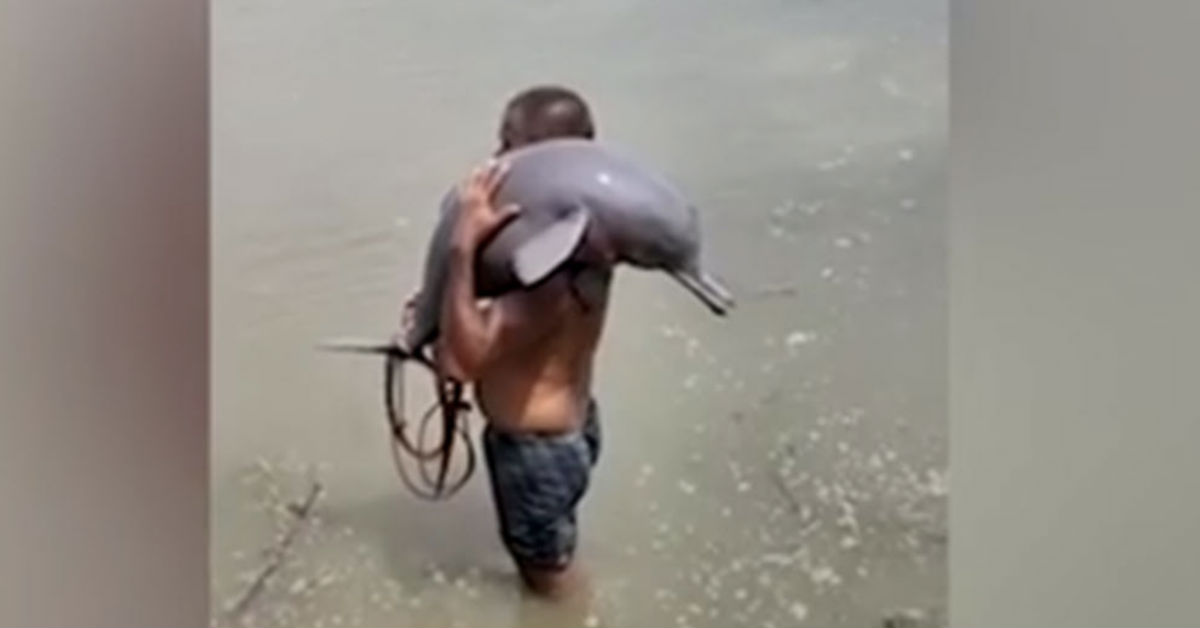Fisherman Carries Endangered Dolphin To Safety After Accidentally Catching It In His Net
World Wildlife states that dolphins are one of the oldest creatures in the world.
The Ganges River dolphin in India was discovered in 1801. They once lived in Nepal, India in the Ganges-Brahmaputra-Meghna and Karnaphuli-Sangu rivers. These dolphins are very important to India to the point that the government declared this dolphin their National Aquatic Animal in 2009. The Ganges River dolphin is protected by the India Wildlife Act.
These specific dolphin species are extinct and they can only live in freshwater. They are essentially blind and they hunt by emitting ultrasonic sounds that bounce off of fish and other prey that they can eat. This way, they can “see” in their minds an image of the prey.
These dolphins usually thrive in small groups or they can live alone. A mother and calf also travel together. At birth, the calves are chocolate brown in color but their hairless skin turns grey-brown in adulthood. The females Ganges River dolphins are larger in size compared to the males. They give birth to one calf once every two to three years partly because of the infrequency of their breeding. They can grow to between seven and 8.9 feet in length and weigh up to 374 pounds.
This is why this species is critically endangered. In fact, there are only 1,200 to 1,800 of them left. They’re important because they’re a reliable indicator of the entire river ecosystem’s health. People living in this region love these dolphins. They know how rare these dolphins are.
That’s why when a fisherman accidentally caught one in his fishing net on July 3rd, he carried it to safety. The fisherman is Mohammed Qayum and this happened in Purnia, India. A video is going around the internet and this shows how he was carrying the giant fish to safety away from the nets that are frequently in the Parmesan river in Purnia. The man gently cradles the huge mammal and untangled some rope that had become caught in the dolphin’s tail fin.
One of the witnesses said, “The dolphin had strayed into the Parmaan River from the Ganges. Consequently, the aquatic mammal got entangled in the fishing net. A massive crowd gathered in the area to get a glimpse of the mammal.”
Stories reveal that the dolphin managed to stray from the Ganges River into the Parmaan river,. A witness shared that his occurrence doesn’t happen often. That is why as soon as the authorities were made aware of the incident by the villagers, a forest team department immediately visited the area and took the dolphin to safety.
India’s new ban on cetacean captivity will hopefully lead to renewed interest in protecting the country’s Ganges River dolphin. Belinda Wright from the Wildlife Protection Society of India said, “I hope this will put some energy into India’s Action Plan for the Gangetic Dolphin, which is supposed to run until 2020.”
Since India has officially recognized the dolphins as non-human persons, their rights to life and liberty will always be respected. And because of this, all Dolphin parks across the country were shut down.
However, everyone is hoping that other wild animals will also receive the same kind of protection as those of the dolphins.

